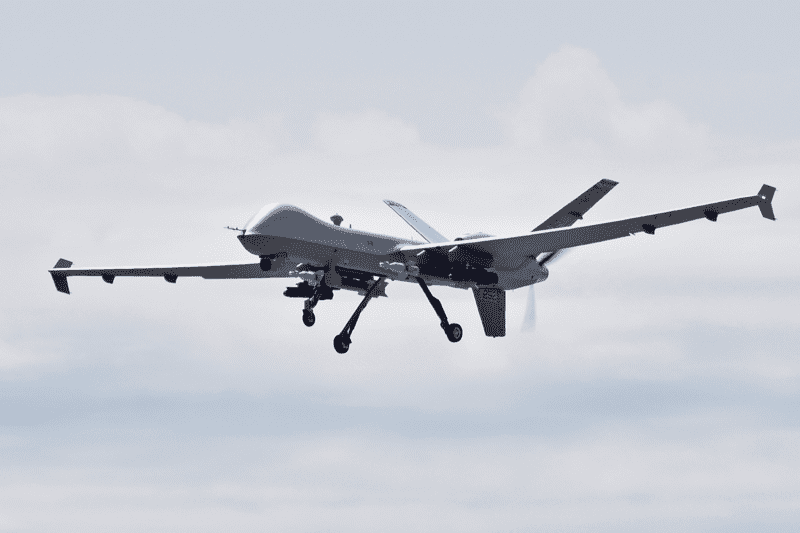
On Tuesday, an American MQ-9 Reaper drone was crashed into the Black Sea by two Russian Su-27 fighter jets while it was conducting a mission over international waters. The drone wasn’t destroyed by a missile strike but rather was forced into a precipitous flight path after one of the Russian jets dumped fuel on the UAV several times while flighting right behind it, before the risky maneuvers finally culminated with a collision that hit the propeller of the drone.
The two Russian jets hovered around the $30-million drone for about 40 minutes, performing more than a dozen intimidating maneuvers.
“Our MQ-9 aircraft was conducting routine operations in international airspace when it was intercepted and hit by a Russian aircraft, resulting in a crash and complete loss of the MQ-9,” Air Force Gen. James B. Hecker, commander of US Air Forces Europe and Air Forces Africa, said in the statement. “In fact, this unsafe and unprofessional act by the Russians nearly caused both aircraft to crash.”
The interception of foreign or unidentified aircraft is rather routine. When an aircraft breached the airspace of a country, fighter jets are quickly scrambled to approach the aircraft and make contact. Their job is to escort the interloper outside the airspace like security guards, or guide the aircraft to a landing strip if the intruding aircraft has a malfunction and an unlawful breach of airspace was the only option.
However, sometimes fighter jets intercept aircraft in international airspace, which should be fair game to navigate. Such routine flights take place when a potentially dangerous foreign aircraft comes too close to the legal, restricted national airspace. Both Russia and NATO intercept each other’s aircraft regularly, and such episodes have only become more common since the 2022 invasion of Ukraine.
In 2022, NATO fighter jets scrambled 570 times to monitor Russian military flights in international airspace, which is nearly double the figure reported for 2021.
According to NATO, Russian military aircraft often do not transmit flight information or communicate with air traffic controllers, which can be a potential threat to civilian aviation.
The downing of the Reaper drone is the effect of Russia’s “coercive signaling”
It’s not clear how often Russia intercepts NATO military flights because the Kremlin does not report such figures, but when they do — as the latest Reaper drone fiasco highlights — they often do so rather recklessly. This is by intent, something that security experts call “coercive signaling”, as a tool to compel and deter the US and its allies in Eastern Europe.
Dara Massicot, a senior policy researcher at the Rand Corporation, is part of a team that has extensively studied Russian coercive signaling. In a recent thread, she highlights other close passes with Russian jets that could have gone horribly wrong. These episodes were compiled in a 2020 report titled Understanding Russian Coercive Signaling, which documents unsafe Russian activity until 2019, so prior to the Ukraine invasion after which such events have become much more frequent. Some of these episodes are quite striking, such as intercepts that come dangerously close, though they fall short of the incredibly aggressive maneuvers performed against the Reaper drone.




In their report, the Rand researchers go into depth to describe the methods employed by the Russian Air Force. In one chapter, they highlight a particularly revealing intercepted recording between the pilots of Russian jets and ground control, which contain express order to compel a change in the flight path of a U.S. B-52 flying over the Baltic Sea.
Ground control instructs: “The task is to come closer, following safety guidelines, identify the type of airplane, country, and, if possible, do not let it further into Black Sea waters. Change the course of the target to 180.”
The controller repeats: “The task is: One of you stands in front, the other one stands behind. Try to push [it] in the opposite direction or on the course 180.”
The Su-27 pilots comply but their initial attempts did not force the B-52 to change course. “We fulfilled the task, but it does not follow the orders s,” they report.
The pilots are then instructed to continue tailing the B-52 and perform other aggressive maneuvers.
Later that day, a Russian Su-27 intercepted a different U.S. B-52 in international airspace over the Baltic Sea. The Russian Su-27, which had taken off from Kaliningrad, followed the B-52 “well into” Danish airspace over the island, according to NATO Allied Air Command.
All of this is to say that the incident with the Reaper drone is not evidence of some novel escalation between Russia and NATO. This behavior has been documented behavior quite consistently.


